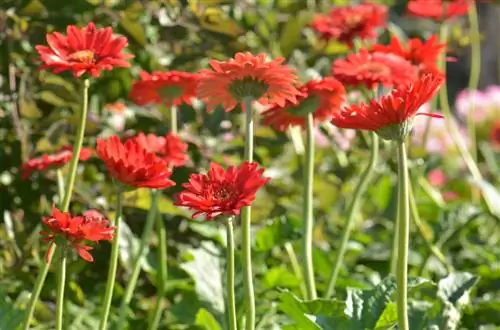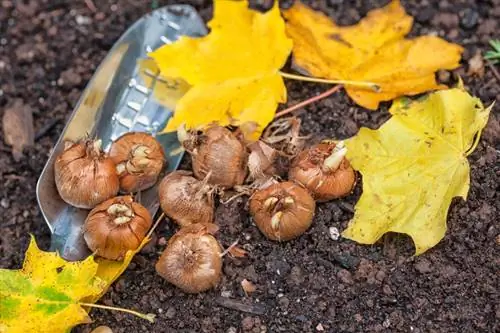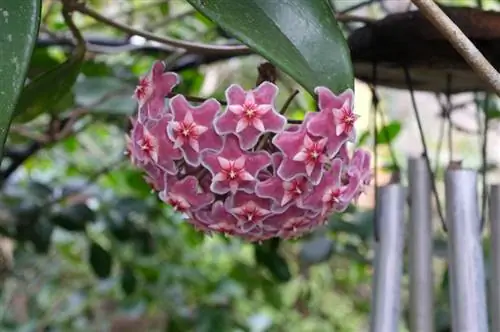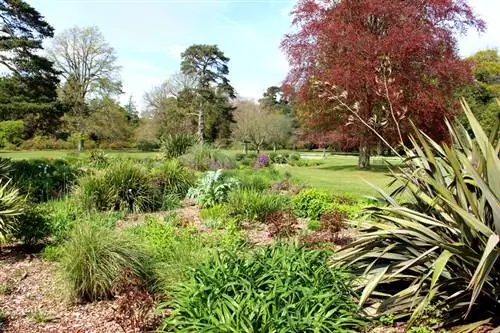- Author admin [email protected].
- Public 2023-12-25 17:45.
- Last modified 2025-01-23 11:22.
With its delicately nodding bell flowers, the chess flower decorates natural wet meadows, the stream and the edge of the pond in spring. The onion flower with the purple-white checkerboard pattern is rarely discovered in the wild. Reason enough to place this distinctive beauty in the garden. Still open questions about cultivation are brought to the point here.
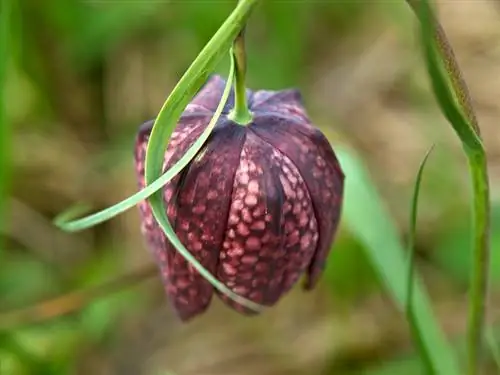
How to care for the chess flower in the garden?
The chess flower (Fritillaria meleagris) is a bulb flower that thrives in wet meadows, streams and pond edges. It prefers sunny to partially shaded locations, fresh, moist to swampy soils, slightly acidic pH values and regular organic fertilization from March to May.
Planting chess flowers correctly
In order to showcase its artfully drawn bell flowers, the chess flower requires a sunny to partially shaded location with fresh, moist to boggy soil and a slightly acidic pH value. Here you prepare the plaice finely crumbled and create small planting holes at a distance of 15-20 cm. A thin layer of sand on the sole prevents harmful onion rot. Plant the bulbs with the tip pointing upwards. The planting depth corresponds to a maximum of three times the bulb height. After you have consolidated the soil with your hands, water with soft water.read more
Care tips
A constantly moist soil is the top priority for the professional care of a chess flower. The lapwing egg gratefully accepts organic fertilization in the form of compost, guano, bark humus or plant manure every 4 weeks from March to May. If you want to self-sow, wait for the seeds to form and their natural distribution. To save a checkerboard flower from this effort, cut off the withered flowers as soon as possible. The foliage remains on the plant until it is completely absorbed. The onion needs some time to assimilate and store the remaining nutrients. Adult Fritillaria meleagris are completely hardy. To be on the safe side, consider light winter cover in the form of leaves and brushwood. A continuous water supply is even more important in frosty, dry winter weather.read more
Which location is suitable?
The chess flower develops its full beauty under sunny to partially shaded lighting conditions. Fresh, moist to swampy soil is of utmost importance for he althy growth and lush abundance of flowers. One of the main reasons for their withdrawal from the outdoors is the ruthless draining of wetlands and swamps.read more
The correct planting distance
The optimal planting distance for the chess flower is made up of a value within the group and another value as the distance to the bed neighbors. Since a single Fritillaria meleagris hardly catches the eye, ideally arrange the flower in small tuffs with 5 to 10 specimens. Place these at a distance of 15-20 cm from each other. Since a lapwing egg does not like to be harassed, the distance to plants of other genera should be at least 30 cm.
What soil does the plant need?
The chess flower prefers a place in boggy to freshly moist soil. If the soil is free of lime and has a slightly acidic pH value, the lapwing egg feels in good hands. There should be plenty of humus, while the nitrogen content is at best at a low level. It is therefore better to stay away from a location in sandy, dry soil. Correspondingly, we recommend compost-based potting soil as a substrate in pots and balcony boxes, ideally enriched with a handful of rhododendron soil as an acidic component.
What is the best time to plant?
The best time to plant all kinds of bulbous flowers is August and September. In this regard, the chess flower is no exception. The plant is well established by the first frost. A layer of leaves helps the lapwing egg survive the first winter well and emerge vitally at the end of March.
When is flowering time?
The central flowering period extends from April to May. Mild weather encourages the distinctive flower to sprout earlier from March. By mid-May at the latest, the curtain will fall on the garden stage for the chess flower, ensuring a seamless transition to the summer flowers. With their leaves and flowers, these decoratively cover the gaps caused by the retracted Fritillaria meleagris.read more
Cutting the chess flower correctly
Under the loving hands of a gardener, the chess flower can live to a proud age of up to 80 years, especially if it is left as alone as possible. However, pruning is necessary at least once per season. Once a Fritillaria meleagris has finished its spring-fresh flower festival, it is time for seed heads. Give the plant time to go to seed in the garden if dispersal is desired. Do not cut off the wilted flowers and yellowed leaves too early. The onion needs some time to absorb all the remaining nutrients in it as a valuable reserve for the next season.
Watering the chess flower
One of the main pillars of skilful care is a balanced water balance. Water the chess flower as soon as the substrate surface has dried. Waterlogging must be avoided at all costs, otherwise rot could occur. It is an advantage if you predominantly use soft, lime-free water to accommodate the desire for a slightly acidic soil.
Fertilize the chess flower properly
One of the most uncomplicated aspects of caring for a chess flower is the supply of nutrients. How to properly fertilize the spring flower:
- Work a portion of compost (€43.00 on Amazon) superficially into the soil every 4 weeks from March to May
- Administer a liquid fertilizer in a diluted concentration to the lapwing egg in the pot or flower box once a month
A Fritillaria meleagris does not tolerate a concentrated load of nitrogen, such as a complete fertilizer, well. If compost is not available, we recommend using a commercially available organic fertilizer such as guano or bark humus.
Pests
While the toxic content and unpleasant onion smell keeps voles at bay, the chess flower is at the top of the menu for voracious snails. To prevent these slimy pests from attacking the leaves and flowers, a traveling barrier acts as a repellent. Surround the tuffs with a circle of sharp materials, such as chippings or sawdust. Coffee grounds prove to be extremely effective in the fight against snails. The caffeine it contains has a toxic effect on the pests.
Wintering
In view of the delicate silhouette of a chess flower, the robust winter hardiness is surprising. The flower bulb can tolerate temperatures of up to -28 degrees Celsius without complaint, especially under a protective blanket of snow. However, we recommend covering it with leaves and brushwood during the planting year, as the young plant has not yet fully established itself. The greater threat comes from winter drought stress. If there is no snow in the bitter cold, the roots will not get a single drop of water. Therefore, water a checkerboard flower when there is a clear frost on mild days.
Propagate chess flower
The vegetative scale propagation of a chess flower is easy for hobby gardeners to handle. As a lily plant, the onion is made up of several layers that are ideal for breeding. In addition, well-established specimens develop daughter bulbs that serve for propagation in a similar manner. Once the foliage is fed and trimmed, follow these steps:
- Dig up and clean an onion
- Remove a maximum of 6 outer scales
- Alternatively cut off existing daughter bulbs
- Fill small pots with potting soil
- Insert the scales halfway up and pour from below
- Plant the onions with the tip pointing upwards approx. 6 cm deep
- Put a transparent hood over each pot until the first shoots appear
- Replant the mother bulb
In a partially shaded location at 20-23 degrees Celsius, keep the substrate constantly moist while the onion scales or daughter bulbs develop their own root system. Throughout the winter, cover the future checkerboard flowers with soil so that only the tip of the scales is visible. At 5-8 degrees Celsius in the dark basement, water only enough to prevent the soil from drying out. From March onwards, look after the young plants in a bright window or balcony spot until they are mature in autumn for planting in beds or pots.
Propagation by sowing, on the other hand, is much more complex. Since the seeds are cold germinators, stratification is necessary in advance to put the seeds in a germination mood. In addition, a chess flower propagated from seedlings takes 3-4 years until the first flowering.read more
Chess flower in a pot
The cultivation of a chess flower is not limited to the bed or the edge of the pond. In the pot, the lapwing egg with its beautifully marked bell-shaped flowers elegantly ushers in spring on the sunny to partially shaded balcony. As a substrate, we recommend a mix of potting soil, rhododendron soil and a handful of sand for best permeability. A drainage made of pottery shards above the water drain in the bottom of the pot prevents unwanted waterlogging. Plant the bulbs 10-12cm apart in small groups with the tip facing upwards. The ideal planting depth is three times the height of the bulb. This is how you properly care for the chess flower in the pot:
- Watere regularly with soft water
- Fertilize liquidly every 4 weeks from March to May
- Cut off wilted flowers so that the flower saves energy
- Only cut the leaves when they have completely dried in
The chess flower spends the winter in the dark, cool basement. Every now and then give a drink of water to prevent the substrate from drying out. There is no fertilization during wintering.read more
Is chess flower poisonous?
With its poison content, the chess flower defends itself against predators and pests. The toxic alkaloids are concentrated in the bulb, making the flower dangerous for children and pets. In the blink of an eye, a flower bulb disappears into the mouth and triggers significant symptoms of poisoning, such as vomiting, cramps and even circulatory collapse. The spring bloomer is therefore not the best choice for the family garden.read more
Trivia
People like to call the chess flower a lapwing egg, based on the well-known wading bird, which, as a ground breeder, prefers to lay its spotted eggs in tall meadow grass. The title couldn't have been chosen more appropriately, because it is exactly this location where the checkerboard flowers feel extremely comfortable.
Beautiful varieties
- Alba: Where the color concept of the checkerboard pattern doesn't harmonize, the pure white variety comes in handy
- Artemis: The elegant chess flower impresses with white and green, nodding flower bells
- Charon: Magnificent, black and purple diced bell flowers for a dramatic appearance in the bed
- Poseidon: Subtle floral pattern in pink-purple for an unobtrusive design option


